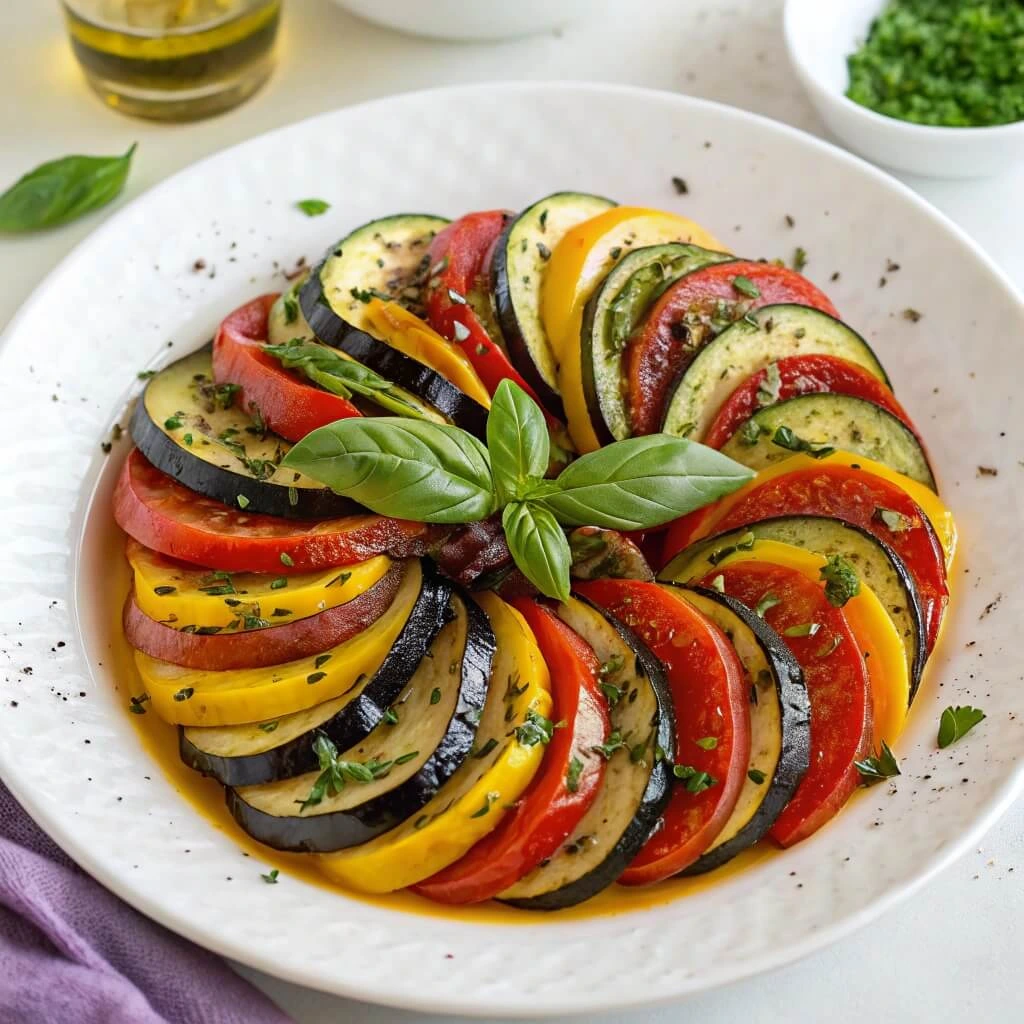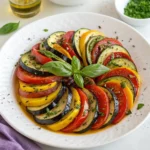Have you ever had a dish that feels like a warm hug from the French countryside? Ratatouille, a classic from Provence, is more than just a veggie stew. It celebrates fresh, seasonal produce and the joy of simple cooking. Whether you’re a pro chef or new to cooking, this healthy, gluten-free ratatouille recipe is tasty and versatile. Imagine tender eggplant, zucchini, and bell peppers cooked with herbs and garlic. This makes a flavor-packed meal perfect for weeknights or special gatherings.
Why not fall in love with ratatouille again? It’s a crowd-pleaser for any mood. Serve it as a main dish, a side, or on crusty bread for a quick snack. Plus, it helps you add more veggies to your diet without losing flavor. Ready to bring a taste of Southern France to your table? Let’s dive into this easy ratatouille recipe that’s sure to be a family favorite!
Key Benefits of Ratatouille Recipe
Ratatouille recipe is more than a dish—it’s a culinary adventure. It’s versatile and delicious. Here’s why it deserves a spot in your recipe book:
- It’s healthy and full of nutrients. Packed with veggies like eggplant, zucchini, and bell peppers, it’s rich in vitamins, antioxidants, and fiber. This makes it a guilt-free, satisfying meal. For more on the health benefits of these vegetables, check out this resource from Harvard T.H. Chan School of Public Health.
- It fits any diet. Whether you’re vegetarian, vegan, or gluten-free, ratatouille works. It’s also low in calories, great for those watching their intake.Learn more about gluten-free diets from Celiac Disease Foundation.
- It’s comfort food with a twist. This dish is comforting but healthy, with a Mediterranean touch. The mix of tender veggies and herbs gives it a rustic yet refined flavor.
- It’s meal prep friendly. Ratatouille tastes even better the next day. Make a batch on Sunday and enjoy it all week as a side, main, or topping for grains and pasta.
- It’s versatile. Serve it hot or cold, as a main or side. Pair it with bread, quinoa, or grilled chicken for a complete meal. The options are endless!
By adding ratatouille to your cooking routine, you’re not just making a meal—you’re embracing a healthier, more flavorful way of eating. Ready to start? Let’s gather the essentials and dive into this delicious recipe!
Essential Ingredients for the Best Ratatouille
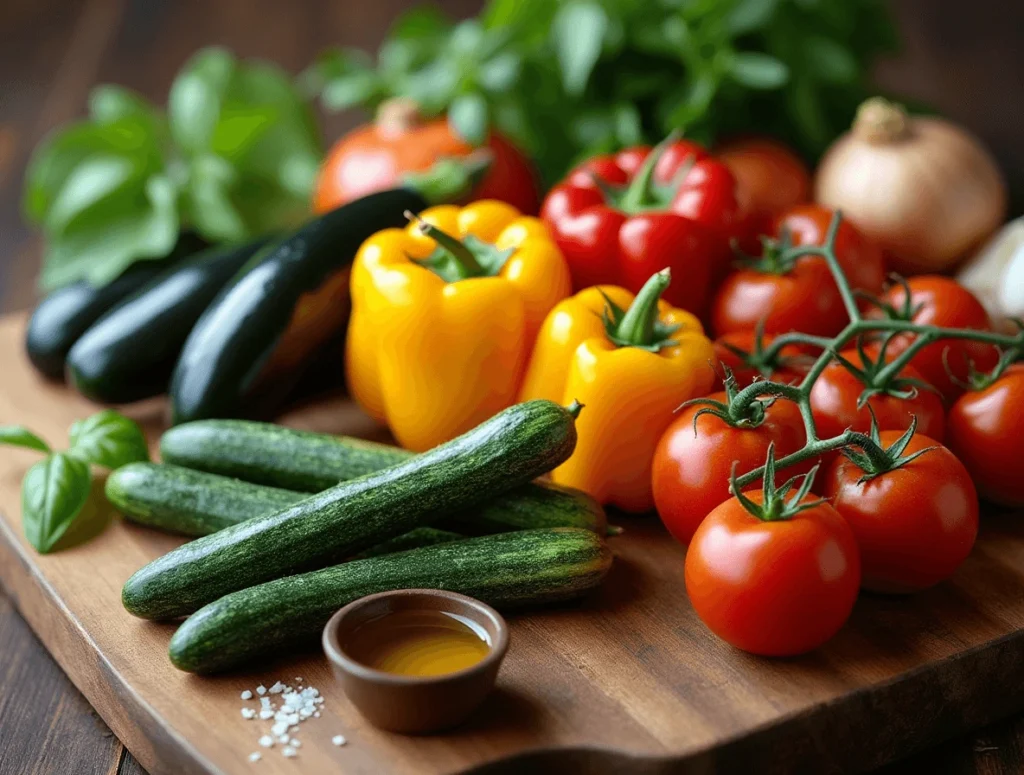
Great ratatouille starts with fresh, high-quality ingredients. Choose ripe, flavorful veggies. Here’s what you need:
- Eggplant (1 medium): Look for firm, glossy eggplants. They add a meaty texture and soak up flavors well.
- Zucchini (2 medium): Fresh zucchini should feel heavy and have bright green skin. It adds sweetness and balance.
- Yellow Squash (1 medium): This adds color and a buttery flavor, complementing the zucchini and eggplant.
- Red Bell Pepper (1 large): Sweet and vibrant, it adds natural sweetness and vitamins.
- Roma Tomatoes (4-5): These are less watery and have a strong tomato flavor, helping create a rich sauce.
- Yellow Onion (1 large): Onions are the flavor base. Yellow onions are slightly sweet and caramelize well.
- Garlic (4 cloves): Fresh garlic gives ratatouille its savory aroma.
- Olive Oil (3-4 tablespoons): Use good-quality extra virgin olive oil for flavor and even cooking. For more on choosing quality olive oil, visit Olive Oil Times.
- Fresh Herbs: A mix of fresh basil, thyme, and a bay leaf adds a fragrant, earthy note.
Pro tip: Chop your veggies into uniform pieces for even cooking and a harmonious texture. With these essentials, you’re set to make a beautiful and delicious dish.
Easy Step-by-Step Instructions for Homemade Ratatouille Recipe
Ready to make this classic French dish? It’s simpler than it seems! Follow these steps for a flavorful, comforting meal:
- Prep Your Veggies: Wash and dry all veggies. Dice the eggplant, zucchini, yellow squash, and red bell pepper. Chop the onion and mince the garlic. This ensures even cooking and blending.
- Sauté the Aromatics: Heat 2 tablespoons of olive oil in a large skillet over medium heat. Add the chopped onion and sauté for 3-4 minutes until translucent. Stir in the minced garlic and cook for another minute until fragrant. This step builds the rich flavor base.
- Cook the Veggies: Add the diced eggplant and cook for 5-6 minutes. Then add the zucchini, yellow squash, and red bell pepper. Season with salt, pepper, and a pinch of thyme. The veggies will soften and release their juices.
- Simmer with Tomatoes: Once the veggies are tender, add the chopped Roma tomatoes and bay leaf. Reduce the heat to low and simmer for 20-25 minutes. The tomatoes will break down, creating a rich sauce. Stir occasionally to prevent sticking.
- Finish with Fresh Herbs: Remove the skillet from heat and discard the bay leaf. Stir in a handful of freshly chopped basil. Drizzle with a little extra olive oil for a glossy finish. Your ratatouille is ready to serve!
Pro Tip: For a polished look, layer sliced veggies in a baking dish and bake at 375°F (190°C) for 30-40 minutes. This gives you the iconic spiral look from the movie Ratatouille.
Making ratatouille is as enjoyable as eating it. With these easy steps, you’ll create a flavorful meal perfect for any occasion.
Pro Tips and Creative Ratatouille Variations

Now that you’ve mastered the basics, let’s take it up a notch! Ratatouille is versatile—ready for your personal touch. Here are tips and variations to make it your own:
Pro Tips for Perfect Ratatouille:
- Use Seasonal Veggies: Choose veggies that are in season for the best flavor.
- Don’t Overcook: Keep an eye on the texture. Veggies should be tender but hold their shape.
- Layer Flavors: Add a splash of balsamic vinegar or red pepper flakes for extra depth.
- Let It Rest: After cooking, let the ratatouille sit for 10-15 minutes to meld flavors.
Creative Ratatouille Recipe Variations:
- Cheesy Ratatouille: Sprinkle grated Parmesan or crumbled goat cheese on top before serving. The creamy cheese pairs well with the hearty veggies.
- Spicy Ratatouille: Add red pepper flakes or smoked paprika for a warm, smoky kick.
- Grilled Ratatouille: Grill the veggies for a charred, smoky flavor. Toss with tomato sauce and herbs. Perfect for summer barbecues.
- Vegan Ratatouille: Skip the cheese and use tahini or nutritional yeast for a cheesy flavor.
- Deconstructed Ratatouille: Serve the veggies and sauce separately. Let everyone build their own bowl, great for family-style meals.
Ratatouille invites creativity. Whether you stick to the classic recipe or try a variation, you’ll create something delicious and memorable. Experiment and make this timeless dish your own!
How to Store and Serve Ratatouille
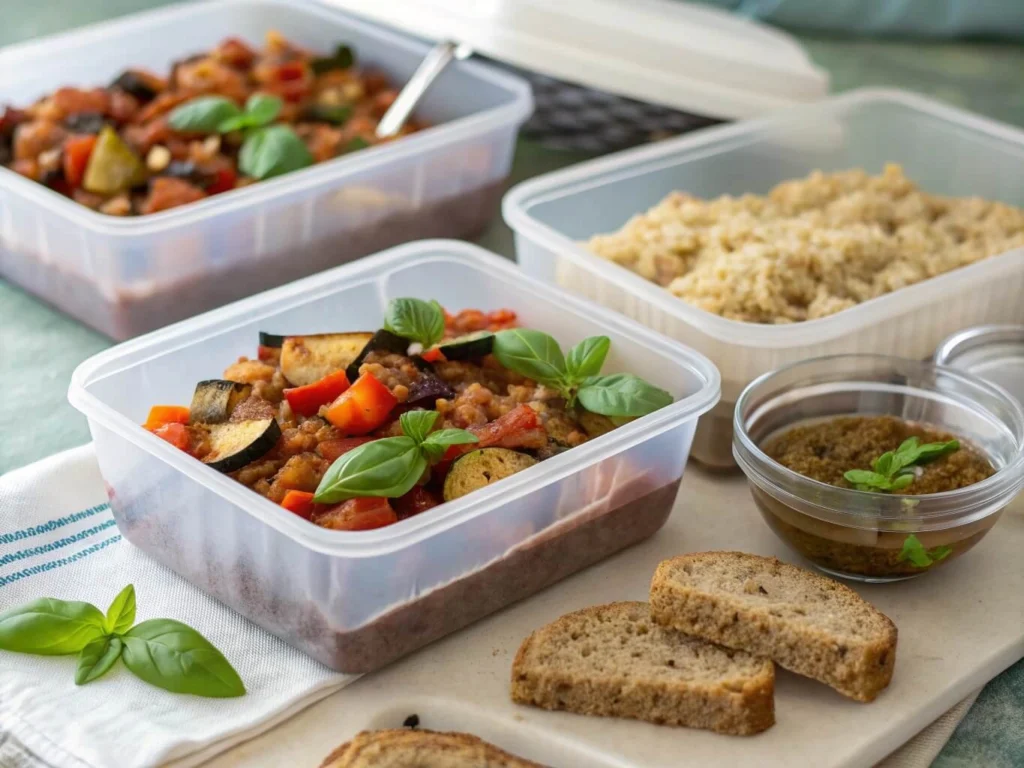
Ratatouille improves with time when stored and served right. Follow these tips to keep it flavorful:
Storing Ratatouille:
- Allow It to Cool: Let your ratatouille cool completely before storing to prevent moisture buildup.
- Use Airtight Storage: Transfer cooled ratatouille into airtight containers. This keeps it fresh and prevents it from absorbing other food smells.
- Refrigeration: Ratatouille keeps well in the fridge for up to five days. Store it in the main compartment for consistent temperature.
- Freezing for Longer Preservation: For longer storage, freeze ratatouille in portions. Leave space at the top of the container for expansion.
- Labeling: Always label your containers with the date to track storage time.
Serving Ratatouille:
- Gentle Reheating: Reheat ratatouille slowly on the stovetop over low heat, stirring occasionally. In the microwave, reheat in short bursts to avoid overcooking.
- Creative Serving Ideas:
- Side Dish: Serve with roasted chicken or grilled fish.
- Over Grains: Ladle over rice, couscous, or quinoa.
- With Bread: Enjoy with a crusty baguette or on toasted bread.
- Egg Companion: Use as a base for poached eggs or in an omelet.
- Enhancing the Flavor: Add a splash of olive oil or balsamic vinegar before serving. Fresh herbs like thyme or oregano add a nice touch.
- Garnish Options: Sprinkle grated cheese like parmesan or crumbled goat cheese for richness and saltiness.
With these storage and serving tips, your ratatouille will stay delicious and ready to enjoy anytime.
History of Ratatouille
Ratatouille recipe has a rich history rooted in the rural traditions of Provence, France. It started in the city of Nice. Farmers made it using summer vegetables from their gardens. The name “ratatouille” comes from the Occitan word “ratatolha,” which means a chunky stew.
Over time, ratatouille became a staple in French cooking. It’s loved for its simplicity and flavor. Each family often has its own recipe, passed down through generations. The dish became famous worldwide with the 2007 animated film “Ratatouille.” The movie showed its culinary charm and the joy of cooking with fresh ingredients.
Today, ratatouille is enjoyed around the world. It’s appreciated for its versatility and how it showcases the natural flavors of vegetables. Whether served as a main course or a side dish, it brings people together over good food.
Ratatouille Recipe Around the World
Many cultures have their own versions of vegetable stews. For example :
- Italy: Caponata, a Sicilian dish made with eggplant, tomatoes, and capers.
- Spain: Pisto, a similar dish often served with eggs or bread.
- India: Baingan Bharta, a spiced eggplant dish.
Conclusion – Why Ratatouille Recipe Deserves a Spot in Your Kitchen
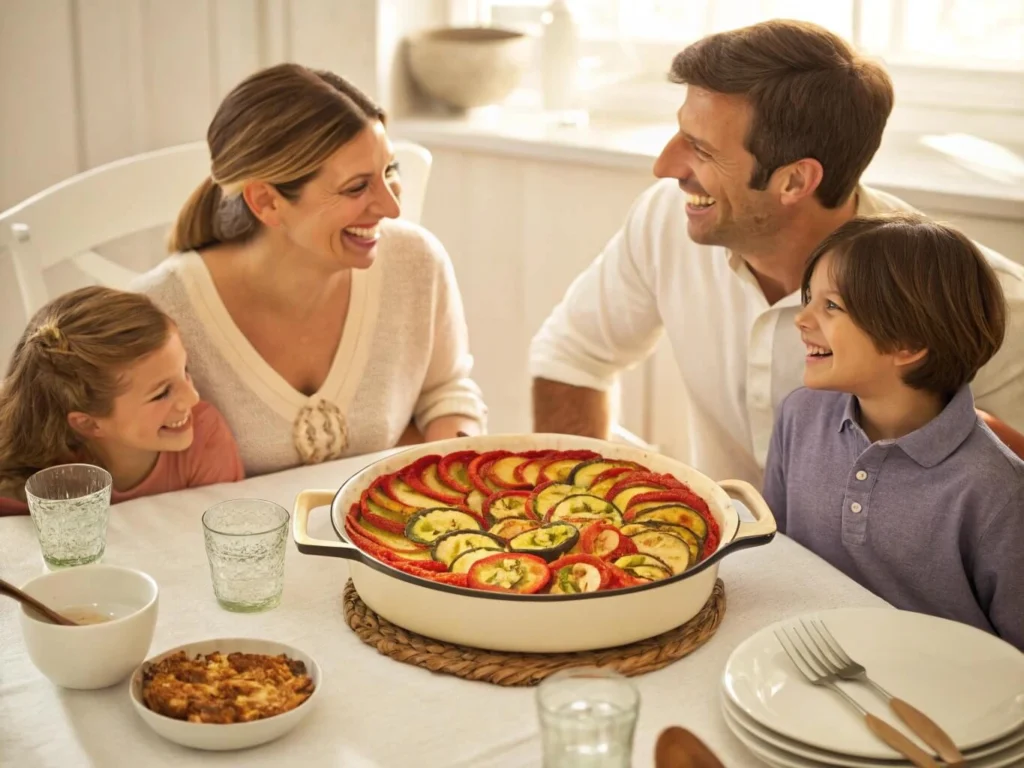
Ratatouille recipe is a beloved dish for good reason. It celebrates simplicity, flavor, and wholesome ingredients. Whether you’re a seasoned cook or a beginner, ratatouille is creative and satisfying.
Here’s why you’ll love it:
- It’s versatile: Fits every occasion, from cozy dinners to elegant sides.
- It’s nutritious: Packed with vitamins, antioxidants, and fiber.
- It’s easy to make: Simple steps and fresh ingredients create a bistro-quality dish.
- It’s meal-prep friendly: Tastes better the next day, perfect for busy schedules.
- It’s a crowd-pleaser: Impresses family and friends.
Ratatouille is more than a recipe—it’s a culinary experience that brings people together. Give it a try, and you’re bound to fall in love with this timeless dish.
Ratatouille Recipe
Ingredients
Eggplant
- 1 medium
- Look for firm glossy eggplants. They add a meaty texture and soak up flavors well.
Zucchini
- 2 medium
- Fresh zucchini should feel heavy and have bright green skin. It adds sweetness and balance.
Yellow Squash
- 1 medium
- This adds color and a buttery flavor complementing the zucchini and eggplant.
Red Bell Pepper
- 1 large
- Sweet and vibrant it adds natural sweetness and vitamins.
Roma Tomatoes
- 4-5
- These are less watery and have a strong tomato flavor helping create a rich sauce.
Yellow Onion
- 1 large
- Onions are the flavor base. Yellow onions are slightly sweet and caramelize well.
Garlic
- 4 cloves
- Fresh garlic gives ratatouille its savory aroma.
Olive Oil
- 3-4 tablespoons
- Use good-quality extra virgin olive oil for flavor and even cooking.
Fresh Herbs
- A mix of fresh basil thyme, and a bay leaf adds a fragrant, earthy note.
Instructions
Prep Your Veggies:
- Wash and dry all veggies.
- Dice the eggplant, zucchini, yellow squash, and red bell pepper.
- Chop the onion and mince the garlic,this ensures even cooking and blending.
Sauté the Aromatics:
- Heat 2 tablespoons of olive oil in a large skillet over medium heat.
- Add the chopped onion and sauté for 3-4 minutes until translucent.
- Stir in the minced garlic and cook for another minute until fragrant,this step builds the rich flavor base.
Cook the Veggies:
- Add the diced eggplant and cook for 5-6 minutes.
- Add the zucchini, yellow squash, and red bell pepper.
- Season with salt, pepper, and a pinch of thyme. The veggies will soften and release their juices.
Simmer with Tomatoes:
- Once the veggies are tender, add the chopped Roma tomatoes and bay leaf.
- Reduce the heat to low and simmer for 20-25 minutes. The tomatoes will break down, creating a rich sauce. Stir occasionally to prevent sticking.
Finish with Fresh Herbs:
- Remove the skillet from heat and discard the bay leaf.
- Stir in a handful of freshly chopped basil.
- Drizzle with a little extra olive oil for a glossy finish. Your ratatouille is ready to serve!
Notes
Nutrition Information (per serving)
- Calories:150 kcal
- Fat:8g (Saturated Fat: 1g)
- Protein:4g
- Carbohydrates:18g (Fiber: 6g, Sugar: 10g)
- Sodium:300mg
- Vitamin C:60% DV
- Iron:10% DV
FAQs – Your Ratatouille Recipe Questions Answered
Got questions about making ratatouille? Here are some common questions and answers:
Yes, you can! While fresh tomatoes add a bright, summery flavor, canned tomatoes are a reliable substitute when fresh ones aren’t available. Look for high-quality canned tomatoes that are plain and free from added flavors. This ensures your ratatouille still has a rich, flavorful base.
When stored properly in an airtight container, ratatouille stays fresh for 4-5 days. Interestingly, it often tastes even more delicious the next day as the flavors blend and deepen.
Ratatouille freezes well. Simply portion it into freezer-safe containers, leaving space for expansion. Stored this way, it lasts up to 3 months. Thaw it overnight in the fridge before reheating.
Serve it over quinoa, couscous, or crusty bread for a hearty meal. Or pair it with grilled chicken, fish, or roasted meats. You can even enjoy it cold at picnics.
Ratatouille is perfect for meal prep. Its flavors deepen over time, making it even tastier. Just reheat gently before serving.
Ratatouille is versatile and forgiving. With these tips, you’ll confidently create a meal everyone will love!

